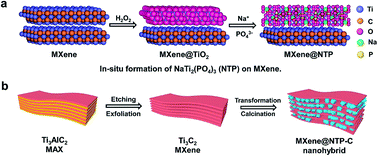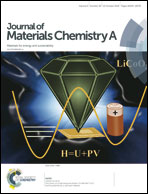In situ formation of NaTi2(PO4)3 cubes on Ti3C2 MXene for dual-mode sodium storage†
Abstract
Due to the promising application of sodium ion batteries (SIBs) in stationary energy storage, great effort has been devoted to the development of anode materials, such as capacitance-type MXenes, battery-type metal sulfides/selenides and red phosphorus. However, these materials severely suffer from either low rate capability or insufficient lifespans. Toward this end, a dual-mode sodium storage concept is proposed based on the simultaneous incorporation of capacitance-type and battery-type electrochemical behavior. Correspondingly, a novel strategy of in situ formation of NaTi2(PO4)3 cubes on Ti3C2 MXene nanosheets in a liquid transformation way was developed to fabricate a dual-mode anode material (denoted as MXene@NTP-C). Acting as the anode material for SIBs, MXene@NTP-C shows outstanding rate capacities (49% capacity retention at 10 A g−1) and remarkable cycling performance (remaining stable after 10 000 cycles at 5 A g−1). Electrochemical and kinetic analyses reveal that this excellent performance was attributed to the dual-mode accommodation (46–71% capacitive contribution at 0.1–1 mV s−1) of sodium onto pseudocapacitance-type MXene and into battery-type NaTi2(PO4)3. The dual-mode sodium storage concept proposed here provides an opportunity to tackle the trade-off between energy and power densities.



 Please wait while we load your content...
Please wait while we load your content...